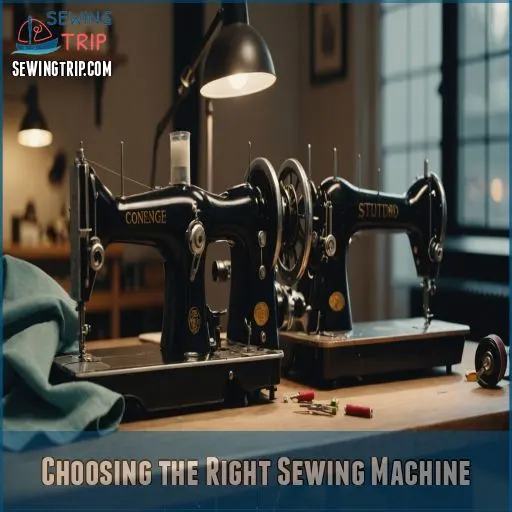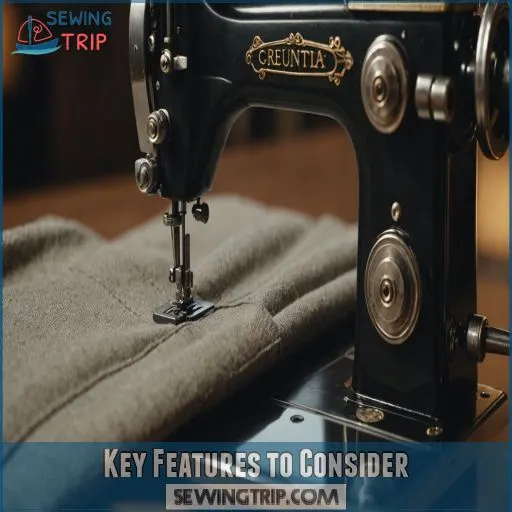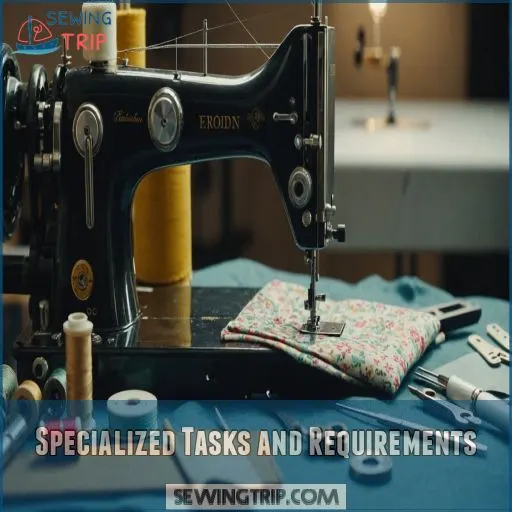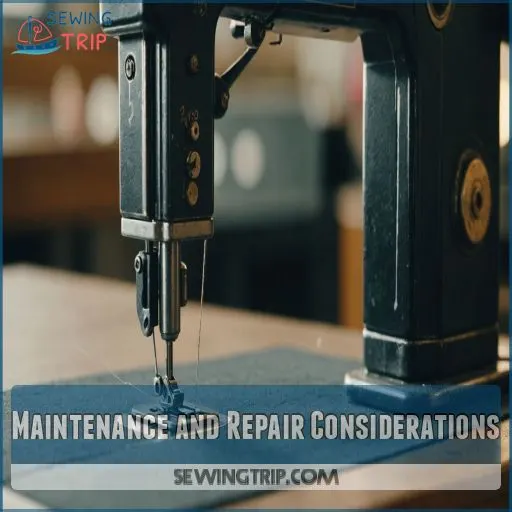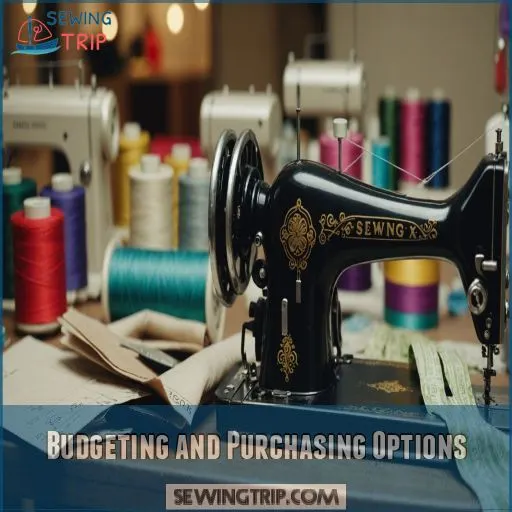This site is supported by our readers. We may earn a commission, at no cost to you, if you purchase through links.
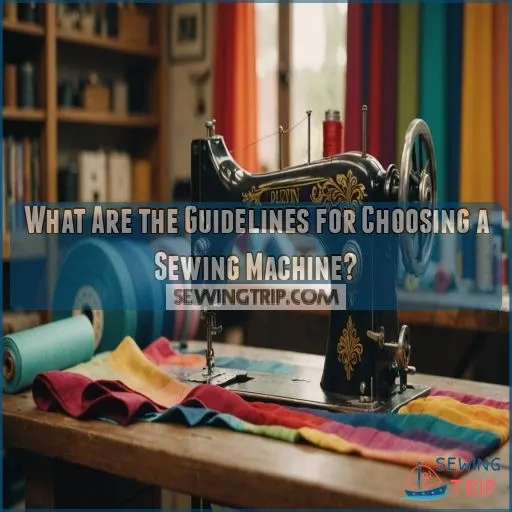
Adjustable stitch width and length are must-haves for versatility. Think about the machine’s weight if you’ll be toting it around. For beginners, user-friendly features like automatic threading are a godsend.
Advanced sewists might want computerized options with fancy stitches. Remember, a good machine should feel like an extension of your creative hands.
Stick around to unravel the mysteries of mechanical vs. computerized and why your future self will thank you for considering maintenance needs.
Table Of Contents
Key Takeaways
- You’ll want to match your sewing machine to your needs and budget. Think about the projects you’ll tackle – are you quilting up a storm or just hemming pants? Your answer will guide you to the right features, from basic straight stitches to fancy embroidery options.
- Don’t shy away from test-driving different machines. It’s like finding the perfect dance partner – you need to feel the rhythm together. Check out local sewing shops, where you can get hands-on experience and expert advice. Who knows, you might even stumble upon a great deal!
- Consider the long game when it comes to maintenance and support. A machine that’s easy to clean and has readily available spare parts will be your trusty sidekick for years to come. It’s like choosing a car – you want one that won’t leave you stranded on the side of the road.
- Remember that, whether you’re eyeing a mechanical workhorse or a computerized wonder, you should focus on the features that will make your sewing sing. You don’t need all the bells and whistles if you’re just starting out, but a few key functions, like adjustable stitch length and an automatic buttonhole, can be game-changers.
Choosing the Right Sewing Machine
Choosing the right sewing machine can feel like hunting for the perfect pair of jeans—there’s a lot to think about, but the perfect fit is out there.
Think about how often you’ll sew, the projects you want to tackle, and your budget to narrow down the choices and find your match.
Types of Sewing Machines by Purpose
Choosing the right sewing machine feels like finding a needle in a haystack, but don’t lose your thread!
Embroidery machines make your fabrics come alive with intricate designs, while quilting machines handle big cozy quilts with ease.
Whether sewing for beginners or crafting home decor, there’s a perfect sewing machine waiting to bring your imaginative ideas to life.
Types of Sewing Machines by Functionality
Now, let’s take a closer look at the exciting world of sewing machine functionality.
You’ve got household sewing machines for everyday tasks, heavy-duty machines for thicker materials, and embroidery machines for creative flair.
Consider combo machines if you’re juggling tasks, or stick to manual machines for simplicity.
For tech-savvy sewers, computerized sewing machines offer precision and advanced features. They provide an ideal option for those seeking precision and advanced features.
Determining Your Sewing Needs and Budget
When you’re figuring out your sewing machine needs, think about your sewing frequency and project goals.
Whether you’re tackling denim jackets or delicate quilts, your fabric types and skill level matter.
Node your budget, as a machine with the right features can save frustration.
Start with a simple sewing machine guide for beginners if you’re finding your feet.
Brand Loyalty and Customer Support
You’ll want to think about a brand’s reputation for quality and customer support from top sewing machine brands when choosing a sewing machine top sewing machine brands
.
Look for generous warranty coverage, reliable repair services, and an active community forum where you can get your questions answered.
Prioritize brands with a track record of satisfied customers and a commitment to helping sewers succeed.
Considering Online Reviews and Ratings
Understanding customer support, you also want to peek behind the curtain of online reviews and ratings.
They offer insight into real-world experiences, though you’ll need a grain of salt for user bias. Look for consistent patterns in reviews, such as reliability and specific features.
Honest feedback can provide a roadmap for your sewing machine journey, guiding your choices wisely with real-world experiences.
Key Features to Consider
When choosing a sewing machine, think about the size and weight, especially if you plan to move it around; no one wants a workout just getting it to the table.
Also, consider the variety of stitches, adjustable features, and handy options like buttonhole settings and presser feet, which can make your projects come to life without unnecessary headaches.
Sewing Machine Size and Weight
Choosing a sewing machine involves balancing size and weight for space, portability, and storage.
Consider these:
- Space: Make sure it fits your sewing area.
- Portability: If you travel, a lightweight option is best.
- Stability: Heavier machines can be more stable.
- Maneuverability: Smaller machines suit children or beginners.
Finding the perfect fit feels like a tailor-made choice!
Number and Types of Stitches
Imagine browsing through a rainbow of stitch options on your sewing machine—it’s like a candy store for sewists!
With a mix of basics like straight and zigzag stitches, along with fun buttonhole and satin stitches, you’ve got plenty to play with.
Prioritize stitch quality, and consider what stitch functions you’ll frequently use for maximum stitch customization.
Adjustable Stitch Width and Length
A trusty sewing machine offers adjustable stitch width and length, giving you stitch precision and control over various fabric types, like those you’d encounter in quilting and patchwork projects
.
Explore your creativity without hesitation!
- Stitch Width: Experiment by adjusting to match your fabric thickness or design intent.
- Stitch Length: Customize to achieve different stitch effects for unique design possibilities.
- Control & Accuracy: Smoothly handle detailed projects with ease.
Buttonhole Construction and Options
With buttonhole construction, whether you’re going for a simple mechanical sewing machine or a fancy computerized model, focus on buttonhole types and sizes.
One-step buttonhole options can make the process a breeze, while adjustable sizes allow creativity.
Check for buttonhole feet compatibility and troubleshoot techniques to keep your projects smooth as butter (Source).
Included Presser Feet and Accessories
Sewing machines come with a variety of essential feet and accessories that’ll make your projects a breeze.
From the versatile zigzag foot to the precise 1/4 inch piecing foot, these attachments open up new sewing techniques.
Explore the must-have feet for quilting, embroidery, and decorative stitching – your machine’s full potential is just a presser foot away!
Automatic Features and Advanced Functions
When choosing a sewing machine, don’t overlook automatic features that make life a stitch easier.
A computerised sewing machine with built-in embroidery can turn your projects into masterpieces while you sip your coffee.
Consider the following must-haves:
- Automatic needle threader
- Automatic thread cutter
- Stitch memory
- Programmable stitching
- Automatic needle lowering
Such features are game-changers for any sewist’s toolkit.
Specialized Tasks and Requirements
When you’re tackling specialized projects like quilting, embroidery, or upholstery, you’ll need a sewing machine that matches those demands.
Don’t skimp on the features; finding the right machine can keep your craft from turning into a comedy of errors.
Quilting and Embroidery Machines
Getting into quilting and embroidery is a creative journey.
You’ll need a machine with flexible embroidery capabilities, like a large hoop size and powerful embroidery software.
Design transfer gets easier with digitized patterns and keeps your creativity flowing. Don’t overlook machine maintenance—think of it as pampering your sewing machine bobbin!
| Feature | Importance |
|---|---|
| Hoop Size | Allows larger designs |
| Embroidery Software | Easy design editing |
| Design Transfer | Convenient file sharing |
| Machine Maintenance | Ensures smooth operation |
Dressmaking and Garment Construction
After quilting those breathtaking designs, it’s time to think about dressmaking and garment construction.
You’ll want a sewing machine that can handle:
- Various fabric types with ease
- Adjustable stitch length and width
- Versatile pattern selection
- Precise fit and alteration
Remember, with the right setup, you’ll turn heads—not thread—at your next project planning session!
Upholstery and Home Decor
Ready to tackle upholstery and home decor projects? You’ll need a heavy-duty sewing machine that can handle thick fabrics and multiple layers.
Look for a machine with a walking foot or dual feed system to keep layers moving smoothly.
Don’t forget upholstery-specific features like adjustable presser foot pressure and a larger throat space. With the right machine, you’ll be reupholstering chairs and crafting custom curtains like a pro in no time!
Beginner-Friendly Features and Accessories
You’ve mastered upholstery, now let’s talk about features that’ll make your sewing journey a breeze.
The best sewing machines for beginners come with essential stitches and user-friendly perks. Look for auto threading to save your eyes, and a free arm for those tricky sleeves. Budget-friendly options often include basic accessories to get you started.
- A machine that grows with you, like a trusty sidekick
- The satisfaction of threading a needle on your first try
- The freedom to create without limitations
Advanced Features for Experienced Sewists
Experienced sewists, it’s time to take your craft to the next level!
Advanced machines offer features that’ll make you feel like a sewing superhero. Imagine an automatic needle threader that saves your eyes.
Or a dual feed system for tackling tricky fabrics.
With free-motion quilting and a stitch designer, you’ll create masterpieces in no time.
Don’t forget the extended arm for those big projects – you’ll be unstoppable!
Mechanical Vs. Computerized Machines
You’ll find two main types of sewing machines: mechanical and computerized.
Your choice depends on your sewing needs and tech-savviness, with mechanical machines offering simplicity and affordability for beginners.
While computerized ones pack advanced features for those ready to level up their sewing game.
Mechanical Machines for Beginners
Starting your sewing journey? Mechanical machines are your new best friend. They’re the trusty sidekicks for beginners, offering a no-frills approach to stitching. You’ll find these workhorses have all the sewing machine essentials without breaking the bank.
- Straightforward controls – no tech overwhelm here!
- Budget-friendly options for wallet-conscious crafters
- Built-to-last design, perfect for learning the ropes
Computerized Machines for Advanced Sewists
Advanced sewists’ dreams come true with computerized sewing machines. These digital dynamos offer touchscreen controls, custom stitch libraries, and advanced foot control for precision work.
Let’s compare the features that’ll make your heart skip a stitch:
| Feature | Emotion |
|---|---|
| Embroidery integration | Excitement |
| Connectivity options | Wonder |
| Custom stitch libraries | Creativity |
| Advanced foot control | Confidence |
With these high-tech helpers, you’ll feel like a sewing superhero, ready to tackle any project with ease and flair.
Hybrid Machines With Both Options
Imagine having the best of both worlds!
Hybrid sewing machines blend mechanical simplicity with best sewing machines for beginners computerized wizardry
. You’ll get the tactile feel of turning knobs for basic stitches, plus the power to access hundreds of pre-programmed designs at the touch of a button.
It’s like having a vintage Singer and a modern marvel rolled into one (Source).
These versatile machines offer a sweet spot in price range, perfect for those who crave mastery over both old-school and cutting-edge techniques.
Electronic and Programmable Machines
The sewing-machine revolution has arrived! You’re in for a treat with electronic and programmable machines.
These high-tech marvels offer:
- Precision control for perfect stitches every time
- A smorgasbord of built-in stitches to expand your creativity
- User-friendly touchscreens that make sewing a breeze
You’ll feel like a sewing superhero with these features at your fingertips. Just remember, with great power comes a heftier price tag and a steeper learning curve. But hey, who said mastering your craft was easy?
Wireless and Bluetooth Connectivity
With a wave of your hand, you can now control your sewing machine from across the room. Welcome to wireless and Bluetooth connectivity.
When choosing between mechanical and computerized machines, consider the benefits of each – mechanical machines are often more durable and straightforward, while computerized machines offer advanced features like automatic buttonhole and adjustable presser foot pressure.
You’ll feel like a tech-savvy seamstress as you explore these cutting-edge features:
| Feature | Benefit |
|---|---|
| Sewing machine apps | Design on-the-go |
| Remote control | Hands-free operation |
| Smart sewing | Automatic adjustments |
| Data transfer | Instant pattern uploads |
| Wireless upgrades | Future-proof your machine |
Say goodbye to tangled cords and hello to seamless stitching!
Maintenance and Repair Considerations
When you’re picking out a sewing machine, don’t forget to think about how you’ll keep it running smoothly by performing regular sewing machine maintenance
.
You’ll want to think about things like regular maintenance.
You’ll also want to think about fixing common problems, and whether you can easily get spare parts or find someone nearby to repair it if needed.
Regular Maintenance and Cleaning
You’ve mastered your mechanical or computerized sewing machine, but now it’s time to keep it purring like a well-oiled kitten. Regular maintenance is your secret weapon for a long-lasting relationship with your trusty stitching sidekick. Let’s roll up our sleeves and get down to the nitty-gritty of keeping your machine in tip-top shape.
- Gather your cleaning arsenal: lint, pipe cleaners, and sewing machine oil
- De-fuzz like a pro: remove lint from nooks and crannies
- Oil up those moving parts: follow your machine’s lubrication schedule
- Give it a spa day: schedule annual professional servicing
Troubleshooting Common Issues
Ever felt like your sewing machine’s got a mind of its own? Don’t fret. When you’re faced with jams, needle breakage, or pesky thread issues, take a deep breath and play detective.
Check if your needle’s bent or dull – it might be time for a fresh one. Make sure your presser foot is properly positioned and your thread tension dial is adjusted for balanced stitches how to a sewing machine.
Also, keep in mind that your machine’s hand wheel can be used to manually move the needle up and down for precise positioning.
For those mysterious noises, a bit of cleaning can work wonders. Remember, tension’s not just for relationships – adjust your bobbin tension for smoother stitches.
Repair and Replacement Options
Three paths await when your trusty sewing machine hits a snag. Don’t throw in the towel just yet!
Consider these options:
- DIY fixes: Channel your inner mechanic and tackle simple repairs yourself.
- Local repair wizards: Find a nearby sewing machine whisperer for more complex issues.
- Replacement quest: Sometimes, it’s time to bid farewell and start a new stitching adventure.
Remember, a stitch in time saves nine – regular maintenance can prevent major headaches down the road!
Availability of Spare Parts and Accessories
Once your sewing machine becomes your trusty sidekick, you’ll want to keep it purring like a well-oiled cat. Don’t let a missing part turn your creative journey into a wild goose chase! Savvy sewists know the secret sauce: ensuring spare parts and accessories are readily available.
Let’s stitch together a plan to keep your machine in tip-top shape:
| Source | Pros | Cons |
|---|---|---|
| Online Marketplaces | Wide selection, competitive prices | Potential compatibility issues |
| Local Shops | Hands-on advice, immediate availability | Limited inventory |
| Manufacturer Support | Guaranteed fit, warranty coverage | Potentially higher costs |
Remember, brand loyalty isn’t about fancy logos—it’s your ticket to a well-supported sewing adventure.
Local Repair Services and Support
You’ve got your spare parts, but what if your machine throws a tantrum? That’s where local repair services come in handy. Having a nearby sewing machine store can be a real lifesaver when your trusty stitch companion decides to go on strike.
- Quick fixes: Quick fixes eliminate the need to wait weeks for repairs.
- Expert advice: Tap into local technicians’ wealth of knowledge.
- Hands-on help: Get personalized demonstrations and troubleshooting.
- Community perks: Join sewing classes and meet fellow fabric enthusiasts.
With local support, you’ll be back to stitching up a storm in no time!
Budgeting and Purchasing Options
You’re about to start a sewing adventure, but first, let’s talk money and where to snag your perfect machine.
Whether you’re eyeing a shiny new model or considering a pre-loved gem, we’ll explore your options to make sure you get the best bang for your buck without breaking the bank.
Setting a Budget for Your Sewing Machine
The golden rule of sewing machine budgets: don’t break the bank for a budget-friendly option
! Your budget should reflect your sewing ambitions.
For beginners, a basic model under $200 can work wonders. If you’re eyeing quilts or embroidery, prepare to invest more.
Remember, value trumps price – a pricier machine with essential features might save you frustration down the road. Consider repair costs too; a reliable workhorse could be your best long-term investment.
New Vs. Used Machines and Their Advantages
Deciding between a shiny new sewing machine or a trusty old workhorse? Let’s thread the needle on this one!
Both options have their perks:
- New machines: Cutting-edge features, full warranty, pristine condition. When choosing a new machine, consider evaluating your needs like sewing frequency and project types to find the perfect match. This will also help you identify essential stitches and functions that fit your sewing goals.
- Used machines: Budget-friendly, often built to last (especially vintage models)
- Vintage charm: Old machines can have "vintage charm" and unique character
- Support considerations: New machines often come with better customer support
Choose wisely, and you’ll be stitching up a storm in no time!
Online Marketplaces and Retailers
As you weigh your options, sewing machine reviews online marketplaces and retailers can be a great way to find the perfect sewing machine
.
Websites like Amazon, eBay, and specialty sewing stores offer a wide selection of machines, online reviews, and price comparisons.
Be sure to also check shipping costs, payment options, and warranty policies .
Local Sewing Shops and Dealers
While online shopping’s convenient, don’t overlook your local sewing machine dealers. They’re treasure troves of expertise!
You’ll get hands-on demos, personalized advice, and a chance to test-drive different models . Plus, these shops often offer repair services, classes, and a supportive community of fellow sewists [20).
It’s like finding your sewing home away from home – complete with friendly faces and helpful tips to keep your creative juices flowing.
Sales and Discounts to Consider
You’ll want to keep your eyes peeled for sewing machine deals that’ll make your wallet sing.
Black Friday and Cyber Monday are prime times to snag a Singer or Brother at a steal.
Don’t forget to check for holiday sales, seasonal discounts, and clearance events throughout the year.
Sign up for newsletters to get exclusive coupon codes, and you might just land your dream machine without breaking the bank.
Frequently Asked Questions (FAQs)
How to buy the best sewing machine?
Don’t get your threads in a twist!
Choose a sewing machine that fits your needs.
Consider adjustable stitch length and width, buttonhole function, and needle position.
Assess your sewing goals and budget before making the plunge.
How to choose a sewing machine?
Choosing a sewing machine isn’t rocket science.
Consider your sewing goals, budget, and skill level.
Look for essential features like adjustable stitches, buttonhole function, and needle position.
Test-drive machines in-store to find your perfect match.
How difficult is it to buy a sewing machine?
Ever felt like threading a needle in the dark?
Buying a sewing machine isn’t as tricky as it seems.
Consider your skill level, from curious beginner to cocky expert.
With some research, you’ll stitch up the perfect choice in no time.
What should I know before buying a sewing machine?
You’ll want to think about your sewing goals first.
Think about the projects you’ll tackle and the fabrics you’ll use.
Look for machines with adjustable stitch settings, buttonhole functions, and essential feet.
Don’t forget to test before buying!
When choosing a sewing machine What should you consider?
Think about your sewing goals and budget.
Consider features like stitch options, ease of use, and durability.
Don’t forget to test drive machines in-store – it’s like finding your sewing soulmate!
What are 3 guidelines when using a sewing machine?
Keep your fingers away from the moving needle, maintaining a safe distance of about an inch.
Always unplug your machine before making adjustments.
Start slow, especially when you’re getting used to new equipment.
These guidelines will keep you stitching safely.
What is the most reliable brand of sewing machine?
While budget machines falter, top-tier brands stand tall.
Bernina, Singer, and Pfaff lead the pack, each offering unique strengths.
For durability and stitch options, consider Janome.
Juki’s quality shines in both home and industrial settings.
How do I choose my first sewing machine?
Choosing your first sewing machine doesn’t have to be a stitch-up! Consider your budget, desired features, and project types.
Look for beginner-friendly options with drop-in bobbins , metal parts (Source), and essential stitches.
Don’t forget to test-drive before you buy!
How do I manage quilting large projects comfortably?
You’ll feel like a quilting superhero with these tips!
Support the quilt’s weight, use gloves for better grip, and break the project into sections.
Don’t fear starting in the middle – it’s your secret weapon for tackling large quilts comfortably.
What type of batting works best for machine quilting?
Cotton-blend batting is your best bet for machine quilting.
It’s durable, easy to work with, and doesn’t shrink much.
You’ll get that soft, crinkly look without constant pilling.
Remember, bigger is better – go 4" larger than your top.
Can I use my regular sewing machine for quilting?
Get started with quilting with your regular sewing machine.
You’ll need a few key tools like a free motion foot and spray baste.
With practice, you can create beautiful designs, just like on a long-arm machine.
How to achieve even stitches in free-motion quilting?
Practice makes perfect in free-motion quilting.
Lower your feed dogs, use a darning foot, and maintain a steady speed .
Move the fabric smoothly, like dancing under the needle.
Keep your hands relaxed and your stitches will follow suit.
What accessories help with machine quilting ergonomics?
Ergonomic quilting’s a breeze with the right gear.
Snag a custom Sew Steady insert for seamless workspace and easy bobbin access.
Add a wheeled cabinet for flexibility, and ergonomic tools like Prym’s chalk wheel to keep your quilting smooth and strain-free.
Conclusion
Ready to thread your way through the sewing machine maze?
Remember, the guidelines for choosing a sewing machine boil down to your needs, budget, and creative aspirations. Whether you’re eyeing a mechanical workhorse or a computerized wonder, focus on features that’ll make your sewing sing.
Don’t forget to factor in maintenance and support. With these tips in your pocket, you’re all set to find a machine that’ll have you stitching up a storm in no time, and that will make your sewing sing and help you get Happy sewing!

